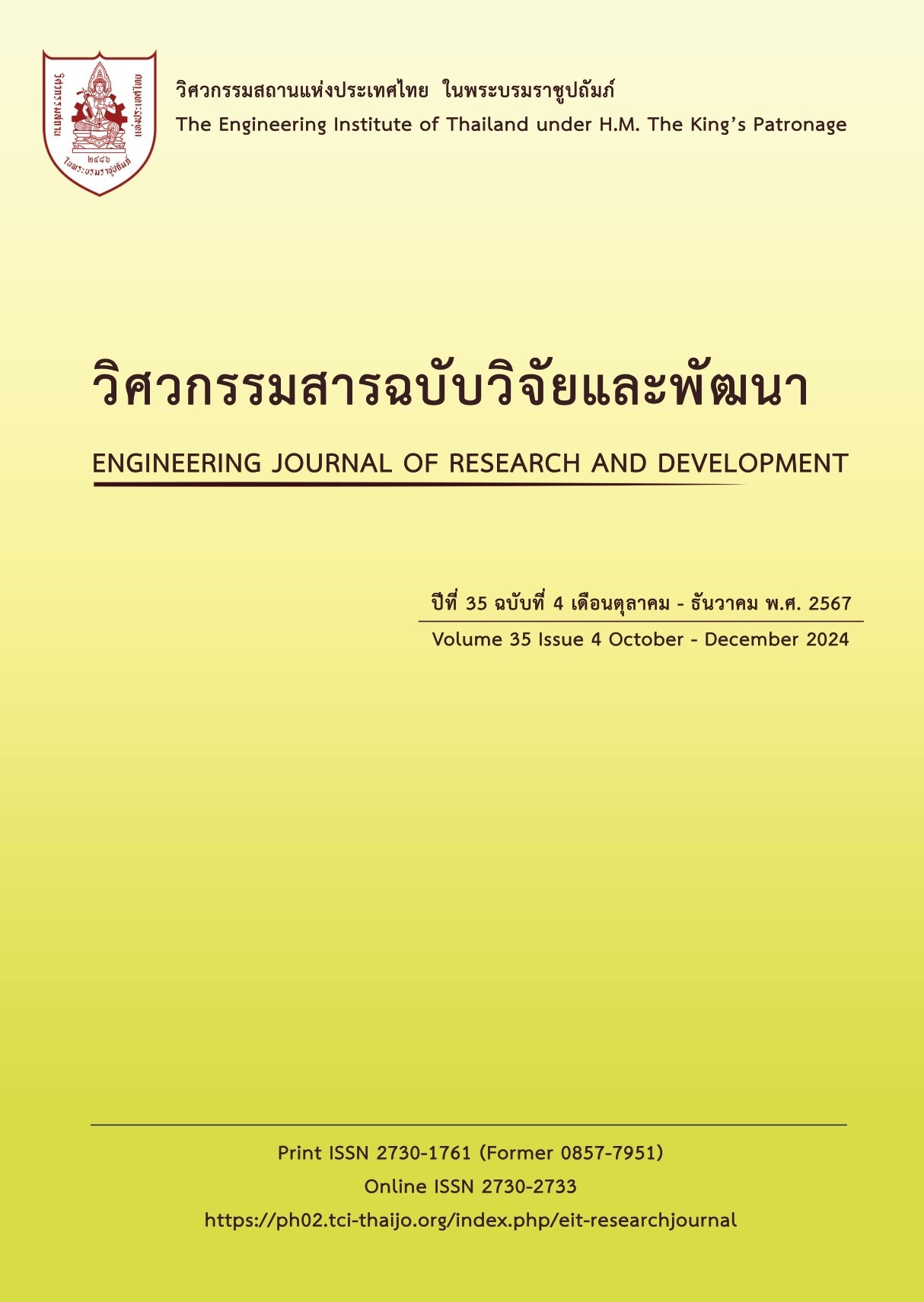STRENGTH AND WATER ABSORPTION PROPERTIES OF UNFIRED BRICKS CONTAINING SUGAR CANE BAGASSE ASH
Main Article Content
Abstract
Bricks have been a widely utilized material in construction, though their production involves a firing process lasting between 7 and 15 days, which causes air pollution. This research had developed unfired bricks mixed with sugar cane bagasse ash to reduce environmental impacts and utilize biomass materials. The cement - soil ratio is 1:6 and finely ground bagasse ash replaces cement at 0, 10, 20, 30, 40, and 50 percent by weight. These mixtures were pressed into blocks, cured, and subjected to testing for compressive strength at 7, 14, 28, 60, and 90 days, water absorption and modulus of rupture at 28 days. The study found that the compressive strength at 7, 14, 28, and 60 days decreased as the amount of bagasse ash increased. Notably, at 90 days, the mixture with 10% bagasse ash substitution exhibited the highest compressive strength. An increase in bagasse ash content also led to a decreased modulus of rupture and higher water absorption. The recommended mixture is one that uses bagasse ash to replace 30% of cement, which had a compressive strength of 60 days or more and water absorption that passes the TIS 77-2565 criteria for quality bricks of grades C. Additionally, plaster applied to these unfired bricks demonstrated good adhesion during construction and plastering tests.
Article Details

This work is licensed under a Creative Commons Attribution-NonCommercial-NoDerivatives 4.0 International License.
The published articles are copyright of the Engineering Journal of Research and Development, The Engineering Institute of Thailand Under H.M. The King's Patronage (EIT).
References
Janpetch N. Quality development of bricks without burning by using polymeric materials from natural latex (Research report), Ayutthaya, 2020.
Janpetch N. Improvement the quality of brick without burn with straw fiber in central region for sustainable commercial use (Research report), Ayutthaya, 2019.
Jethwa, R. H., Momin, S. S., Devi, B. M., Chore, H.S. Evaluation of bagasse ash in stabilization of pavement sub-grade. In: Agnihotri, A. K., Reddy, K. R., Chore, H. S. (ed.). Proceedings of Indian Geotechnical and Geoenvironmental Engineering Conference (IGGEC), Singapore: Springer, 2021, pp. 477-482.
Vaishnava, R., Kumar, A., & Kumar, S. Use of bagasse ash as a filler material in soils. In: International Conference on Smart Technologies for Energy, Environment, and Sustainable Development, India, 4-5 December 2020, pp. 145-151.
Putri, R. D., Apriyanti, Y., & Hambali, R. Utilization of bagasse ash plus cement to increase the shear strength of clay soil. In: IOP Conference Series: Earth and Environmental Science, Indonesia, IOP Publishing, October 2022, pp. 012044.
Dharek, M. S., Sreekeshava, K. S., Vengala, J., Pramod, K., Sunagar, P., & Shivaprakash, M. V. (2022). Experimental investigations on utilization of bagasse ash in adobe bricks. In: Nandagiri, L., Narasimhan, M.C., Marathe, S., Dinesh, S. (ed.). Sustainability Trends and Challenges in Civil Engineering: Singapore: Springer, 2021, pp. 487-496.
Madurwar, M. V., Mandavgane, S. A. and Ralegaonkar, R. V. Use of sugarcane bagasse ash as brick material. Current Science, 2014, 107(6), pp.1044-1051.
Bunjongsiri, K., Chearnkiatpradab, B., and Bunjongsiri, J. A Short review on the utilization of sugarcane bagasse ash in the manufacture of concrete block in Thailand. SAU Journal of Science & Technology, 2020, 6(2), pp. 14-24.
Chusilp, N., Jaturapitakkul, C. and Kiattikomol, K. Utilization of bagasse ash as a pozzolanic material in concrete. Construction and Building Materials, 2009, 23(11), pp. 3352-3358.
Mansaneira, E. C., Schwantes-Cezario, N., Barreto-Sandoval, G. F. and Martins-Toralles, B. Sugar cane bagasse ash as a pozzolanic material. Dyna, 2017, 84(201), pp. 163-171.
Thai Industrial Standard Institute. TCPS 77: 2565. Thai industrial standard of building bricks. Bangkok: TISI, 2022.
Thai Industrial Standard Institute. TCPS 243: 2520. Standard method of sampling and testing brick and structure clay tile. Bangkok: TISI, 1977.
Nokkaew, K., Phaikaew, S., Harachai, K., Metham, M. and Sooksil, N. Quality evaluation of Mon Brick produced in Sanuk Group Province. In: Proceeding of the 27th National Convention on Civil Engineering, Chiang Rai: The Engineering Institute of Thailand under H.M. the King’s Patronage, 2022, pp. MAT04-1-MAT04-6.
Chuchaisong, P, Wongthong, S. Study of the properties of clay bricks produced in Chon Buri Province. BSc project. Burapha University, 2009.


